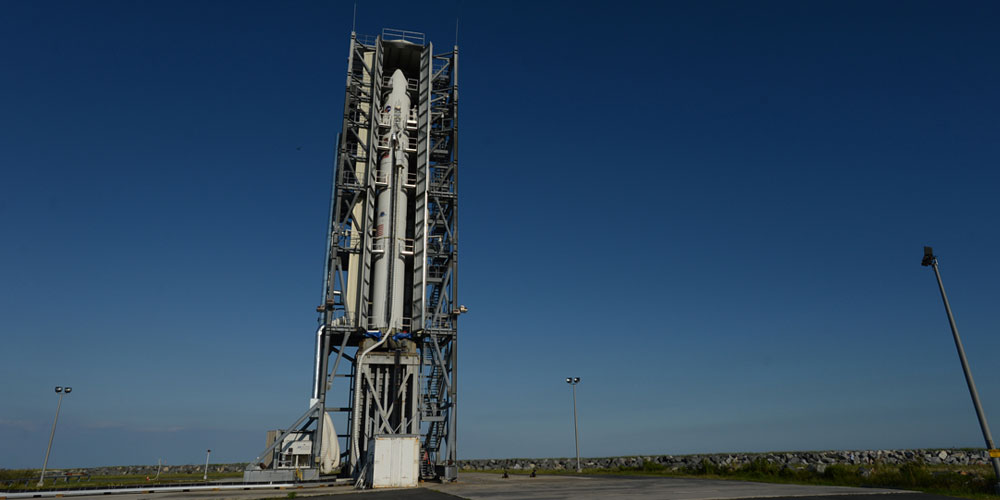NASA spacecraft to study Moon’s atmosphere

A Minotaur V launch vehicle carrying the Lunar Atmosphere and Dust Environment Explorer (LADEE) stands on the launch pad at Wallops Island, Va. on Thursday, Sept. 5, 2013. The rocket is scheduled to launch on Friday, Sept. 6, 2013 just before 11:30 p.m. AP Photo/Eastern Shore News, Jay Diem
WASHINGTON – NASA hopes to unravel more of the Moon’s mysteries Friday by launching an unmanned mission to study its atmosphere, the US space agency’s third such probe in five years.
The Lunar Atmosphere and Dust Environment Explorer (LADEE) is to launch Friday at 11:27 pm (Saturday 0327 GMT) aboard a Minotaur V rocket— a converted peacekeeping missile— from NASA’s Wallops Flight Facility in Virginia.
Since US astronauts last walked on the moon four decades ago, rocket scientists have learned that there is more to the Moon than just a dusty, desolate terrain.
Recent NASA robotic missions such as the Lunar Reconnaissance Orbiter have returned troves of images detailing the Moon’s cratered surface, while NASA’s Gravity Recovery and Interior Laboratory (GRAIL) revealed how being pummelled by asteroids resulted in the Moon’s uneven patches of gravity.
A previous NASA satellite, the Lunar Crater Observation and Sensing Satellite(LCROSS) discovered water ice when it impacted in 2009, the space agency said.
Article continues after this advertisement“When we left the Moon we thought of it as an atmosphere-less ancient surface,” said John Grunsfeld, associate administrator for NASA’s science mission directorate.
Article continues after this advertisement“We have discovered that the Moon scientifically is very much alive, it is still evolving and in fact has a kind of atmosphere.”
The Moon’s atmosphere is so thin that its molecules do not collide, in what is known as an exosphere.
Exploring that exosphere will be a $280 million solar and lithium battery-powered spacecraft about the size of a small car- nearly eight feet (2.4 meters) tall and five feet (1.85 meters) wide.
After launch, LADEE aims to hurtle itself beyond Earth’s orbit so it can circle the Moon, first cruising at a height of about 250 kilometers (156 miles) for just over a month, and then moving lower to 20 to 60 kilometers (12.4 – 37.3 miles) from the surface for the science portion of its mission.
It is carrying an Earth-to-Moon laser beam technology demonstration and three main tools, including a neutral mass spectrometer to measure chemical variations in the lunar atmosphere and other tools to analyze exosphere gasses and lunar dust grains, NASA said.
“These measurements will help scientists address longstanding mysteries, including: was lunar dust, electrically charged by solar ultraviolet light, responsible for the pre-sunrise horizon glow that the Apollo astronauts saw?” NASA said.
Other instruments will seek out water molecules in the lunar atmosphere.
About 100 days into the science portion of the mission, the LADEE spacecraft will do a death plunge into the Moon’s surface.
The spacecraft was made in a modular design that aims to “ease the manufacturing and assembly process” and “drastically reduce the cost of spacecraft development,” NASA said.
Potential future uses of this module could include unmanned probes to an asteroid or to Mars, as well as future Moon probes, though none are planned for now.
US astronauts first walked on the Moon in 1969, and the last explorers of the Apollo era visited in 1972.
The US space agency has no plans to follow LADEE with a human mission to the Moon.
LADEE was conceived when NASA was planning to return humans to the Moon as part of the Constellation program, which President Barack Obama cancelled early in his presidency for being over budget and redundant in its goals.
NASA’s next big human exploration project aims to send humans to Mars by the 2030s.